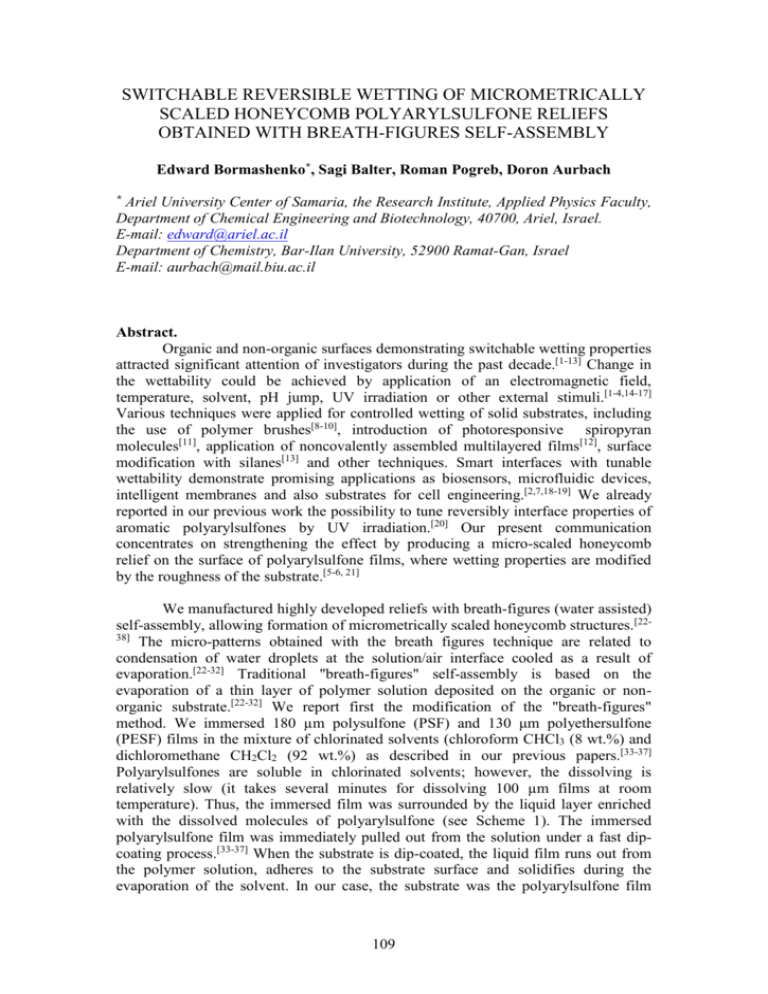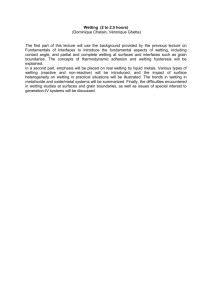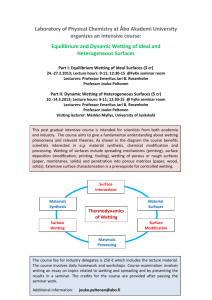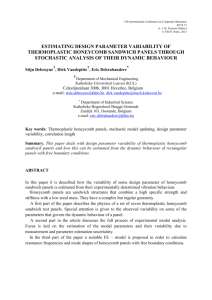Switchable wetting of rough polyarylate films exposed to UV
advertisement

SWITCHABLE REVERSIBLE WETTING OF MICROMETRICALLY SCALED HONEYCOMB POLYARYLSULFONE RELIEFS OBTAINED WITH BREATH-FIGURES SELF-ASSEMBLY Edward Bormashenko*, Sagi Balter, Roman Pogreb, Doron Aurbach * Ariel University Center of Samaria, the Research Institute, Applied Physics Faculty, Department of Chemical Engineering and Biotechnology, 40700, Ariel, Israel. E-mail: edward@ariel.ac.il Department of Chemistry, Bar-Ilan University, 52900 Ramat-Gan, Israel E-mail: aurbach@mail.biu.ac.il Abstract. Organic and non-organic surfaces demonstrating switchable wetting properties attracted significant attention of investigators during the past decade.[1-13] Change in the wettability could be achieved by application of an electromagnetic field, temperature, solvent, pH jump, UV irradiation or other external stimuli.[1-4,14-17] Various techniques were applied for controlled wetting of solid substrates, including the use of polymer brushes[8-10], introduction of photoresponsive spiropyran molecules[11], application of noncovalently assembled multilayered films[12], surface modification with silanes[13] and other techniques. Smart interfaces with tunable wettability demonstrate promising applications as biosensors, microfluidic devices, intelligent membranes and also substrates for cell engineering.[2,7,18-19] We already reported in our previous work the possibility to tune reversibly interface properties of aromatic polyarylsulfones by UV irradiation.[20] Our present communication concentrates on strengthening the effect by producing a micro-scaled honeycomb relief on the surface of polyarylsulfone films, where wetting properties are modified by the roughness of the substrate.[5-6, 21] We manufactured highly developed reliefs with breath-figures (water assisted) self-assembly, allowing formation of micrometrically scaled honeycomb structures.[2238] The micro-patterns obtained with the breath figures technique are related to condensation of water droplets at the solution/air interface cooled as a result of evaporation.[22-32] Traditional "breath-figures" self-assembly is based on the evaporation of a thin layer of polymer solution deposited on the organic or nonorganic substrate.[22-32] We report first the modification of the "breath-figures" method. We immersed 180 µm polysulfone (PSF) and 130 μm polyethersulfone (PESF) films in the mixture of chlorinated solvents (chloroform CHCl3 (8 wt.%) and dichloromethane CH2Cl2 (92 wt.%) as described in our previous papers.[33-37] Polyarylsulfones are soluble in chlorinated solvents; however, the dissolving is relatively slow (it takes several minutes for dissolving 100 µm films at room temperature). Thus, the immersed film was surrounded by the liquid layer enriched with the dissolved molecules of polyarylsulfone (see Scheme 1). The immersed polyarylsulfone film was immediately pulled out from the solution under a fast dipcoating process.[33-37] When the substrate is dip-coated, the liquid film runs out from the polymer solution, adheres to the substrate surface and solidifies during the evaporation of the solvent. In our case, the substrate was the polyarylsulfone film 109 coated with a solution of the same polyarylsulfone in the mixture of chlorinated solvents. The rapid evaporation of the solvent accompanied by water condensation gave rise to honeycomb reliefs depicted in Figure 1. Ideal affinity of the honeycomb relief to the substrate (both are built from the same polyarylsulfone molecules) has to be emphasized. The pattern obtained in our experiments comprised irregularly shaped micro-pores with an average diameter of 1µm, shown in Figure 1. It is noteworthy, that the pores demonstrate neither long-range nor short-range order, contrasting the well-ordered patterns reported in Ref. 22-27. The reliefs presented in Figure 2 demonstrate reversible tunable wettability. The initial contact angles were established as * PSF 107±1.5° and * PESF 96±1.5° for the PSF and PESF reliefes respectively (see Figure 3), * is so called apparent contact angle. [39-40 These angles are larger than those established on the flat extruded PSF and PESF substrates, which are PSF 84±1° for PSF and PESF 79±1° for PESF. It could be recognized that inherently hydrophilic surfaces ( 90 0 ) became hydrophobic ( * 900 ), when textured. This observation means that the CassieBaxter wetting regime occurs; i.e., air is trapped by the honeycomb relief and water droplets sit at least partially on air pockets.[21, 39-41] We already reported that the Cassie wetting regime is typical for polymer honeycomb reliefs.[36, 41] The apparent contact angle * predicted by the Cassie-Baxter formula is given by Equation (1): cos * 1 S (cos 1) (1) In Equation (1) S is the fraction of the liquid/polymer interface. Treatment of the SEM images supplied PSF S 0.73, PESF S 0.82. Thus, Equation (1) yields for the calculated apparent contact angle * PSF,calc 101° and * PESF,calc 91°; the satisfactory correspondence of Cassie angles with experimental ones is recognized. ~ After irradiation with a UV lamp the apparent contact angles of the ~ ~ honeycomb reliefs changed dramatically: PSF 63°, PESF 14° (see Figure 2). This means that the Cassie-Wenzel wetting transition occurred.[42-46] The Cassie-Wenzel wetting transition is well-known to be irreversible.[40, 46] However the initial hydrophobic wetting properties could be restored by external stimuli.[20] We established that heating of the UV-irradiated honeycomb PSF and PESF reliefs restores their initial obtuse apparent contact angles. Several cycles of UV irradiationheating demonstrated the reversibility of the effect, illustrated with Figure 3. We conclude that micrometrically scaled honeycomb polysulfone and polyethersulfone films demonstrate reversibly switchable wetting when subjected to UV irradiation/heating exposure, indicating that the Cassie-Wenzel-Cassie transition is occurring under external stimuli. Polyarylsulfones feature excellent mechanical properties and high thermal stability (the heat deflection temperature of PSF is 174ºC, and of PESF is 204ºC), allowing diverse technological applications of the reported effect. Experimental Extruded PSF (Thermalux) and PESF films were supplied by Westlake Plastics, Inc. Honeycomb reliefs were manufactured as described in Scheme 1 with a fast dipcoating process under ambient temperature. The pulling speed was 43 cm/min, humidity was 40-50%. 110 Reliefs were irradiated with a UV lamp at a wavelength of 254 nm with the intensity of 1 mW/cm2 for one hour. The distance between the polymer film and the UV lamp was 1.5 cm. The restoration of wetting properties was achieved by heating at the temperature of 130°C for 60 minutes. Droplets of 10 μL volume were deposited carefully on the freshly irradiated substrate with a microdosing syringe. Contact angles were established by a homemade goniometer and image-processing technique. A horizontal laser beam illuminated the entire droplet profile and gave an enlarged image on a screen using a system of lenses. Measurements were made on both sides of the droplet and averaged for 10 droplets. Acknowledgments The authors are grateful to Professor M. Zinigrad for his generous support of their experimental activity. The authors are thankful to Mrs. Y. Bormashenko for her help in preparing the paper. References [1] [2] [3] [4] [5] [6] [7] [8] [9] [10] [11] [12] [13] [14] [15] [16] [17] [18] K. Ichimura, S.-K. Oh, M. Nakagawa, Science 2000, 288, 1624. T. P. Russell, Science 2002, 297, 964. X. J. Feng , L. Jiang , Advanced Materials 2006, 18, 3063. J.-Y. Shiu, P. L. Chen, Advanced Functional Materials 2007, 17, 2680. R. Rosario, D. Gust, A. A. Garcia, M. Hayes, J. L. Taraci, T. Clement, J. W. Dailey, S. T. Picraux, J. Phys. Chem. B 2004, 108, 12640. H. S. Lim, D. Kwak, D. Y. Lee, S. G. Lee, K. Cho, J. Am. Chem. Soc. 2007, 129, 4128. H. S. Lim, J. T. Han, D. Kwak, M. Jin, K. Cho, J. Am. Chem. Soc. 2006, 128, 14458. O. Azzaroni, S. Moya, T. Farhan, A. A. Brown, W. T. S. Huck, Macromolecules 2005, 38, 10192. L. Ionov, N. Houbenov, A. Sidorenko, M. Stamm, I. Luzinov, S. Minko, Langmuir 2004, 20, 9916. M. Motornov, R. Sheparovych, I. Tokarev, Y. Roiter, S. Minko, Langmuir 2007, 23, 13. D. Dattilo, L. Armelao, G. Fois, G. Mistura, M. Maggini, Langmuir 2007, 23, 12945. P. F. Driscoll, N. Purohit, N. Wanichacheva, C. R. Lambert, W. G. McGimpsey, Langmuir 2007; 23, 13181. Y. Xiu, L. Zhu, D. W. Hess, C. P. Wong, Nano Lett., 2007, 7 (11), 3388. Y. Zhu, M. Shi., X. Wu, Sh. Yang, Journal of Colloid and Interface Science 2007, 315, 580. T. Sun, G. Wang, Dr. Lin Feng, B. Liu, Y. Ma, L. Jiang, D. Zhu, Angew. Chem. Int. Ed. 2004, 43, 357. Y. H. Lin, H. Ren, Y. H. Wu, S. T. Wu, Y. Zhao, J. Fang, H-Ch. Lin, Optics Express 2008, 16, 17591. A. Be’er, Y. Lereah, Av. Frydman, H. Taitelbaum, Phys. Rev. E 2007, 75, 051601. J. Watanabe, F. Nederberg, B. Atthoff, T. Bowden, J. Hilborn, K. Ishihara, Materials Science and Engineering C 2007, 27, 227. 111 [19] [20] [21] [22] [23] [24] [25] [26] [27] [28] [29] [30] [31] [32] [33] [34] [35] [36] [37] [38] [39] [40] [41] [42] [43] [44] [45] D. Aronov, R. Rosen, E. Z. Ron, G. Rosenman, Process Biochemistry 2006, 41, 2367. Ed. Bormashenko, R. Pogreb, G. Whyman, Ye. Bormashenko, R. Jager, T. Stein, A. Schechter, D. Aurbach, Langmuir, 2008, 24, 5977. Ed. Bormashenko, T. Stein, G. Whyman, Ye. Bormashenko, R. Pogreb, Langmuir 2006, 22, 9982. G. Widawski, M. Rawiso, B. Frančois, Nature 1994, 369, 387. O. Pitois, B. Frančois, Eur. Phys. J. B 1999, 8, 225. S. A. Jenekhe, X. L. Chen, Science 1999, 283, 372. O. Karthaus, N. Maruyama, X. Cieren, M. Shimomura, H. Hasegawa, T. Hashimoto, Langmuir 2000, 16, 6071. M. Srinivasarao, D. Collings, A. Philips, S. Patel, Science 2001, 292, 79. L. R. Song, K. Bly, J. N. Wilson, S. Bakbak, J. O. Park, M. Srinivasarao, U. H. F. Bunz, Adv. Mater. 2004, 16, 115. L. V. Govor, I. A. Bashmakov, R. Kiebooms, V. Dyakonov, J. Parisi, Adv. Mater. 2001, 13, 588. T. Kabuto, Y. Hashimoto, O. Karthaus, Adv. Funct. Mater. 2007, 17, 3569. V. D. Deepak, S. K. Asha, J. Polym. Sci., Part A: Polym Chem. 2008, 46, 1278. L. Ghannam, M. Manguian, J. Francois, L. Billon, Soft Matter, 2007, 3, 1492. M. H. Stenzel, C. Barner-Kowollik, T. P. Davis, J. Polym. Sci., Part A: Polym. Chem. 2006, 44, 2363. E. Bormashenko, R. Pogreb, O. Stanevsky, Y. Bormashenko, T. Stein, V.-Z. Gaisin, R. Cohen, O. Gendelman, Macromol. Mater. Eng. 2005, 290, 114. E. Bormashenko, R. Pogreb, O. Stanevsky, Y. Bormashenko, O. Gendelman, Mater. Lett. 2005, 59, 3553. E. Bormashenko, R. Pogreb, O. Stanevsky, Ye. Bormashenko, T. Stein, R. Cohen, M. Nunberg, V.-Z. Gaisin, M. Gorelik, O. Gendelman, Mater. Lett. 2005, 59, 2461. E. Bormashenko, A. Schechter, O. Stanevsky, T. Stein, S. Balter, Al. Musin, Y. Bormashenko, R. Pogreb, Z. Barkay, D. Aurbach, Macromol. Mater. Eng. 2008, 293, 872. E. Bormashenko, A. Malkin, Al. Musin, Y. Bormashenko, G. Whyman, N. Litvak, Z. Barkay, V. Machavariani, Macromol. Chem. Phys. 2008, 209, 567. L. Billon, M. Manguian, V. Pellerin, M. Joubert, O. Eterradossi, H. Garay, Macromolecules, 2009, 42, 356. P.-G. de Gennes, F. Brochard-Wyart, D. Quéré, "Capillarity and Wetting Phenomena: drops, bubbles, pearls, waves", Springer-Verlag, New York, 2004. A. Marmur, Soft Matter, 2006, 2, 12–17. E. Bormashenko, Ye. Bormashenko, G. Whyman, R. Pogreb, O. Stanevsky, J. Colloid Interface Sci. 2006, 302, 308. A. Lafuma, D. Quéré, Nat. Mater., 2003, 2, 457. E. Bormashenko, R. Pogreb, G. Whyman, Ye. Bormashenko, M. Erlich, Appl. Phys. Lett., 2007, 90, 201917. E. Bormashenko, R. Pogreb, G. Whyman, Ye. Bormashenko, M. Erlich, Langmuir, 2007, 23, 6501. E. Bormashenko, R. Pogreb, G. Whyman, Ye. Bormashenko, M. Erlich, Langmuir, 2007, 23, 12217. 112 [46] E. Bormashenko, R. Pogreb, T. Stein, G.Whyman, M. Erlich, Al. Musin, V. Machavariani, D. Aurbach, Phys. Chem. Chem. Phys., 2008, 10, 4056. polyarylsulfone substrate evaporation of the solution V V molecules of polyarylsulfone solvent B A Scheme 1. Scheme of the manufacturing of honeycomb mocro-reliefs. A B Figure 1. SEM images of polysulfone (A) and polyethersulfone (B) reliefs. 113 A B C D Figure 2. Water droplets deposited on the honeycomb PSF relief before (A) and after (B) UV-irradiation; water droplets deposited on the honeycomb PESF relief before (C) and after (D) UV-irradiation. 114 Figure 3A. Apparent contact angle vs. number of irradiation-heating cycles for PSF films. Figure 3B. Apparent contact angle vs. number of irradiation-heating cycles for PESF films. 115 Cover picture Table of Contents Text Micrometrically scaled honeycomb polymer surfaces demonstrating reversibly tunable wetting properties are reported. Polyarylsulfone based micro-reliefs obtained with a modification of breath-figures method demonstrated reversible changes in their wettability under UV-irradiation/heating cycles. Surfaces demonstrating controlled wetting properties are important for various technological applications, including biosensors, microfluidic devices, intelligent membranes and cell engineering. Micro-scaled honeycomb polyarylsulfone reliefs feature reversible change in their wetting properties when reliefs are exposed to UVirradiation/heating cycles. Micro-pores are important for constituting the CassieBaxter wetting regime and strengthening the jump in the apparent contact angle. A novel technique allowing formation of micro-scaled patterns is reported. We suggest, that the aforementioned arguments justify publication of our communication in Small Journal. 116






